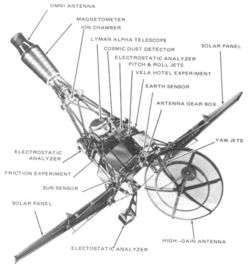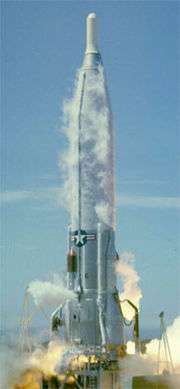Atlas-Agena
 An Atlas-Agena launching Lunar Orbiter 4 | |
| Function | Expendable launch system |
|---|---|
| Manufacturer |
Convair General Dynamics |
| Country of origin | United States |
| Size | |
| Height | 118.0 feet (36.0 m) |
| Diameter | 10.0 feet (3.0 m) |
| Width | 16.0 feet (4.9 m) |
| Mass | 341,000 pounds (155,000 kg) |
| Stages | 2½ |
| Capacity | |
| Payload to LEO | 2,200 pounds (1,000 kg) |
| Payload to GEO | 1,540 pounds (700 kg) |
| Payload to TLI | 850 pounds (390 kg) |
| Payload to escape | 575 pounds (261 kg) |
| Launch history | |
| Status | Retired |
| Launch sites |
LC-12, 13 & 14, CCAFS SLC-3 & 4, Vandenberg |
| Total launches | 109 |
| Successes | 93 |
| Failures | 13 |
| Partial failures | 3 |
| First flight | 26 February 1960 |
| Last flight | 27 June 1978 |
| Boosters | |
| No. boosters | 1 |
| Width | 16.0 feet (4.9 m) |
| Engines | 2 |
| Thrust | 233,000 pounds-force (1,040 kN) |
| Burn time | 134 seconds |
| Fuel | RP-1/LOX |
| First stage | |
| Diameter | 10.0 feet (3.0 m) |
| Engines | 1 |
| Thrust | 67,000 pounds-force (300 kN) |
| Burn time | 5 minutes |
| Fuel | RP-1/LOX |
| Second stage - Agena D | |
| Length | 248 inches (6.3 m) |
| Diameter | 5.0 feet (1.5 m) |
| Engines | 1 Bell Aerospace 8247 |
| Thrust | 16,000 pounds-force (71 kN) |
| Burn time | 265 seconds |
| Fuel | UDMH/IRFNA |
The Atlas-Agena was an American expendable launch system derived from the SM-65 Atlas missile. It was a member of the Atlas family of rockets, and was launched 109 times between 1960 and 1978.[1] It was used to launch the first five Mariner unmanned probes to the planets Venus and Mars, and the Ranger and Lunar Orbiter unmanned probes to the Moon. The upper stage was also used as an unmanned orbital target vehicle for the Gemini manned spacecraft to practice rendezvous and docking. However, the launch vehicle family was originally developed for the Air Force and most of its launches were classified DoD payloads.
The Atlas-Agena was a two-and-a-half-stage rocket, with a stage-and-a-half Atlas missile as the first stage, and an RM-81 Agena second stage. Initially, Atlas D missiles, redesignated as the LV-3, were used as the first stage.[2] These were later replaced by the standardized Atlas SLV-3, and its derivatives, the SLV-3A and B. The final Atlas-Agena launch used an Atlas E/F.
The earliest Agena variant was the Agena A in 1959-60, which did not have restart capability. Most of these were flown on Thor-Agena boosters for the Discoverer program and only four used Atlases (Midas 1, Midas 2, Samos 1, and Samos 2), two of which failed.
Late in 1960, Lockheed introduced the uprated Agena B stage which was restartable and had longer propellant tanks for more burn time. It first flew on the Thor and did not make its maiden voyage on an Atlas for months, when Midas 3 launched on July 12, 1961. Atlas-Agenas were then used for DoD and NASA programs, but proved a reliability nightmare as one failure after another happened. In late 1962, after Ranger 5 suffered another booster malfunction (albeit a minor one that ground controllers were able to work around), NASA convened a review board which undertook a wholesale reevaluation of the Atlas-Agena as a launch vehicle. The board found that quality control and checkout procedures were poor, and that this situation was exacerbated by the several dozen configurations of the booster, as each individual DoD and NASA program necessitated custom modifications to the Atlas and Agena, and the latter also differed in its Atlas and Thor variants. The board recommended improved quality control, better hardware, and also establishing one standardized launch vehicle for all space programs.
The end result was the Atlas SLV-3 and Agena D, standardized versions of the Atlas D core and Agena B which would be the same on every launch (at least as far as the Atlas was concerned, Agena Ds often still had customized setups, especially for DoD payloads). The Agena D first flew in July 1963 for DoD launches, but NASA continued using Agena Bs for the remaining Ranger missions. The Atlas SLV-3 meanwhile first flew in August 1964. Dozens of Atlas SLV-3/Agena D boosters were flown over the following years, mostly for the KH-7 GAMBIT program, also for a few NASA missions. The last Atlas-Agena was flown in 1978 to launch SEASAT, but on a repurposed Atlas F missile rather than the SLV-3.
Launches were conducted from Launch Complexes 12, 13 and 14 at the Cape Canaveral Air Force Station, and Launch Complexes 1 and 2 at Point Arguello (now SLC-3 and 4 at Vandenberg Air Force Base).
Variants
| Name | First launch | Last launch | Launches | Successes | Failures | Partial failures | Remarks |
|---|---|---|---|---|---|---|---|
| Atlas LV-3 Agena-A | 1960-02-26 | 1961-01-31 | 4 | 2 | 2 | 0 | |
| Atlas LV-3 Agena-B | 1961-07-12 | 1965-03-21 | 28 | 21 | 5 | 2 | |
| Atlas LV-3 Agena-D | 1963-07-12 | 1965-07-20 | 15 | 15 | 0 | 0 | |
| Atlas SLV-3 Agena-D | 1964-08-14 | 1967-11-05 | 47 | 41 | 5 | 1 | |
| Atlas SLV-3B Agena-D | 1966-04-08 | 1 | 1 | 0 | 0 | ||
| Atlas SLV-3 Agena-B | 1966-06-07 | 1 | 1 | 0 | 0 | ||
| Atlas SLV-3A Agena-D | 1968-03-04 | 1978-04-08 | 12 | 11 | 1 | 0 | |
| Atlas E/F Agena D | 1978-06-27 | 1 | 1 | 0 | 0 | ||
Production launches
Ranger

The Ranger spacecraft were designed to impact the Moon, returning photographs of the lunar surface until their destruction. The spacecraft was designed in three Blocks, all similar in appearance with a forward antenna and magnetometer, supported by a boom, with more sensors and two solar panels and a dish antenna mounted at the base. The first two Block I spacecraft, Ranger 1 and Ranger 2, were launched on August 23 and November 18, 1961, not to the Moon, but in intended high Earth orbits to test the Atlas-Agena and spacecraft capabilities. However, the orbits were not as high as desired, and the spacecraft were not able to orient themselves to collect solar power.
The Block II missions, Ranger 3, Ranger 4, and Ranger 5, were launched away from Earth in January, April, and October 1962, but all three failed. Ranger 3 missed the Moon entirely. Ranger 4's solar panels failed to deploy, and the navigation system failed, sending the probe to impact the lunar far side without returning any pictures or data. Ranger 5 suffered an unknown failure which deprived it of power, and it missed the Moon by 725 kilometers (391 nautical miles).
Ranger 6, launched January 30, 1964, successfully impacted the Moon but its cameras failed to return pictures. The last three Rangers were finally successful: Ranger 7 in July 1964, Ranger 8 in February 1965, and Ranger 9 in March 1965.
Mariner
The Mariner spacecraft were built by NASA's Jet Propulsion Laboratory. Mariner 1 and Mariner 2 were twins, launched on July 22 and August 27, 1962, to fly by the planet Venus. The first two craft used the same spacecraft bus as the Block I Rangers, each weighing 446 pounds (202 kg) and instrumented to perform radiometric temperature measurements of the planet, and to measure interplanetary magnetic fields and particles.[3][4] Mariner 1's Atlas-Agena malfunctioned and went off course, requiring its destruction approximately 5 minutes after liftoff. Mariner 2 successfully made the 3½-month flight, becoming the first spacecraft to fly by another planet. It carried microwave and infrared radiometers, and sensors for cosmic dust, solar plasma and high-energy radiation, and magnetic fields.

Mariner 3 and Mariner 4 used a redesigned spacecraft bus weighing 575 pounds (261 kg), and were launched on November 5 and November 28, 1964 to fly by the planet Mars. Mariner 3 failed after a successful launch when its nose cone shroud failed to open. These Mariners carried cameras, and Mariner 4 successfully returned pictures of Mars as it flew by.
The 540-pound (240 kg) Mariner 5 was successfully launched to Venus on June 14, 1967 and flew by in October, probing Venus' atmosphere with radio waves, scanning its brightness in ultraviolet light, and sampling solar particles and magnetic field fluctuations above the planet.
Gemini

The Agena rocket stage was used as the passive docking target for the Gemini manned space program. After docking, the Agena could also be fired by the astronauts to raise the combined Gemini-Agena spacecraft into a higher orbit. The first attempt at such a docking mission was made for the Gemini 6 mission on October 25, 1965, but the Agena stage failed to reach orbit.[5] This forced postponement and replanning of the Gemini 6A mission, which performed rendezvous with Gemini 7 without docking.[6]
The GATV was first successfully launched for Gemini 8 on March 16, 1966, permitting the first successful docking in space. GATV-8 was later used as the secondary Agena target for Gemini 10, which also docked with its own GATV. GATV-9 failed at launch in a manner similar to GATV-6, forcing a similar reschedule of the Gemini 9A mission using a backup Augmented Target Docking Adapter atop an Atlas, but with no Agena rocket stage. Two more GATVs were successfully launched and used on Gemini 11 and Gemini 12.
Lunar Orbiter
.jpg)
A series of five Lunar Orbiter spacecraft were launched from August 1966 through August 1967, to help select landing sites for the Apollo manned lunar landing program by mapping the Moon's surface.[7] Each spacecraft weighed 850 pounds (390 kg) and was 4.9 feet (1.5 m) in diameter, minus the four extended solar panels. All launches were successful, and a total of 99 percent of the surface of the Moon (near and far side) was mapped with resolution as high as 3 ft 3 in (1 meter). Altogether the Orbiters returned 2180 high resolution and 882 medium resolution frames. The spacecraft also carried micrometeroid sensors, which showed the average micro-meteoroid flux near the Moon to be two orders of magnitude greater than in interplanetary space, but slightly less than the near-Earth environment.
References
- ↑ Encyclopedia Astronautica - Atlas
- ↑ Gunter's Space Page - Atlas Agena
- ↑ "Tracking Information Memorandom: Mariner R 1 and 2" (PDF). NASA Technical Reports Server. Retrieved December 29, 2011.
- ↑ "Mariner R Spacecraft for Missions P-37/P-38" (PDF). NASA Technical Reports Server. Retrieved December 29, 2011.
- ↑ "Gemini 6 Target - NSSDC ID: GEM6T". NASA GSFC.
- ↑ Barton C. Hacker and James M. Grimwood (1977). "On The Shoulders of Titans: A History of Project Gemini - The Visitors". NASA.
- ↑ Bowker, David E. and J. Kenrick Hughes, Lunar Orbiter Photographic Atlas of the Moon , NASA SP-206 (1971).
